EV Solar Modules Market Size and Trends
The EV solar modules market is estimated to be valued at USD 620.0 Mn in 2025 and is expected to reach USD 2,222.8 Mn by 2032, growing at a compound annual growth rate (CAGR) of 20.0% from 2025 to 2032.
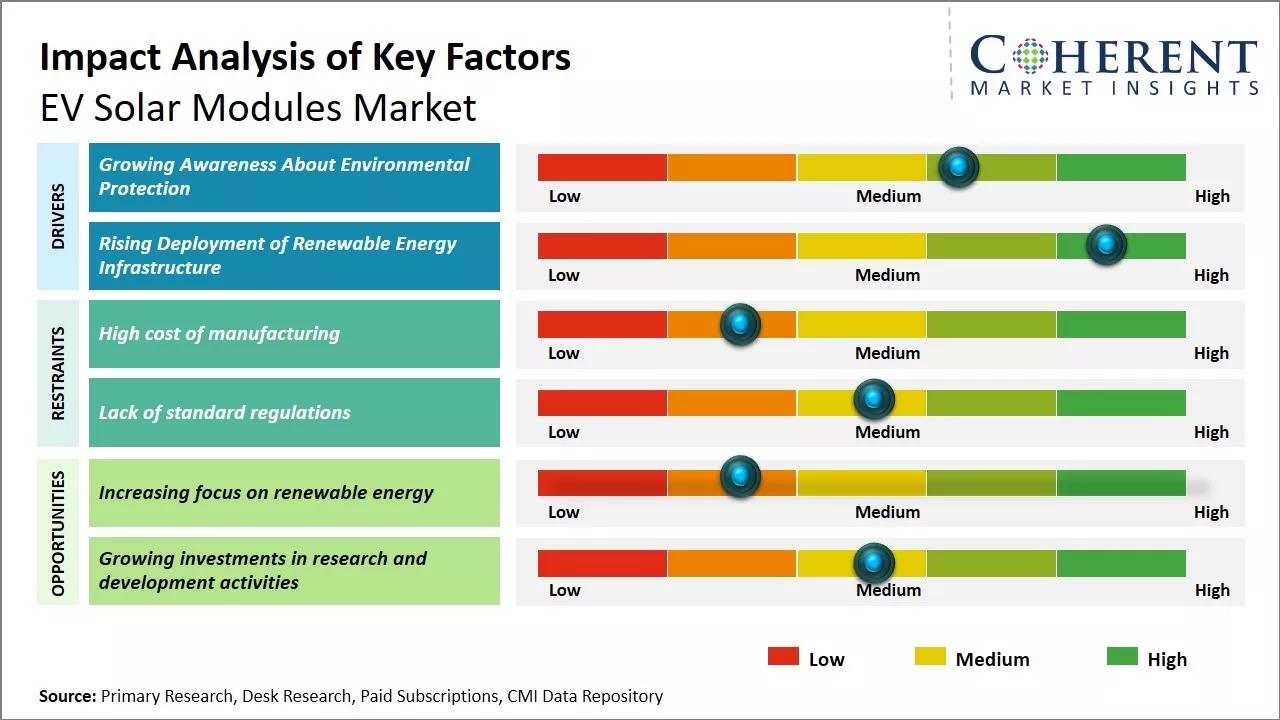
Discover market dynamics shaping the industry: Download Free Sample
The widespread adoption of electric vehicles along with declining costs of solar modules is driving this high growth in the market. Governments across regions are providing various subsidies and campaigns to promote the usage of clean energy in the transportation sector. The EV solar modules market is witnessing rising demand driven by increasing awareness about environmental protection. Manufacturers are investing heavily in research and development to develop more efficient and lightweight solar modules for electric vehicles. They are also focusing on tie-ups with leading EV makers to provide customized solar solutions. Off-grid and commercial vehicle applications remain key target segments for players in this market.
Growing Awareness about Environmental Protection
One of the key drivers for the growth of the EV solar modules market is the growing awareness about environmental protection and sustainability across the world. There is a rising concern about the effects of vehicle emissions and more people are looking to switch to electric vehicles as a solution to curb pollution. Solar modules provide an effective way to power electric vehicles and reduce their dependency on fossil fuels. As people get more educated on the climate crisis, they are willing to invest in clean technologies like solar EV charging infrastructure. Several governments and organizations are also campaigning to promote sustainable transportation and many countries have announced plans to shift entirely too electric mobility in the coming decades in response to the climate change issues. This emphasizes the need for ubiquitous solar charging solutions for EVs on a large scale. Furthermore, innovations are bringing down the costs of solar modules making solar EV charging more economical compared to traditional grid-based systems. Rising environmental consciousness among public as well as support through regulations is expected to drive the demand for solar integration with EVs going forward.
Market Concentration and Competitive Landscape
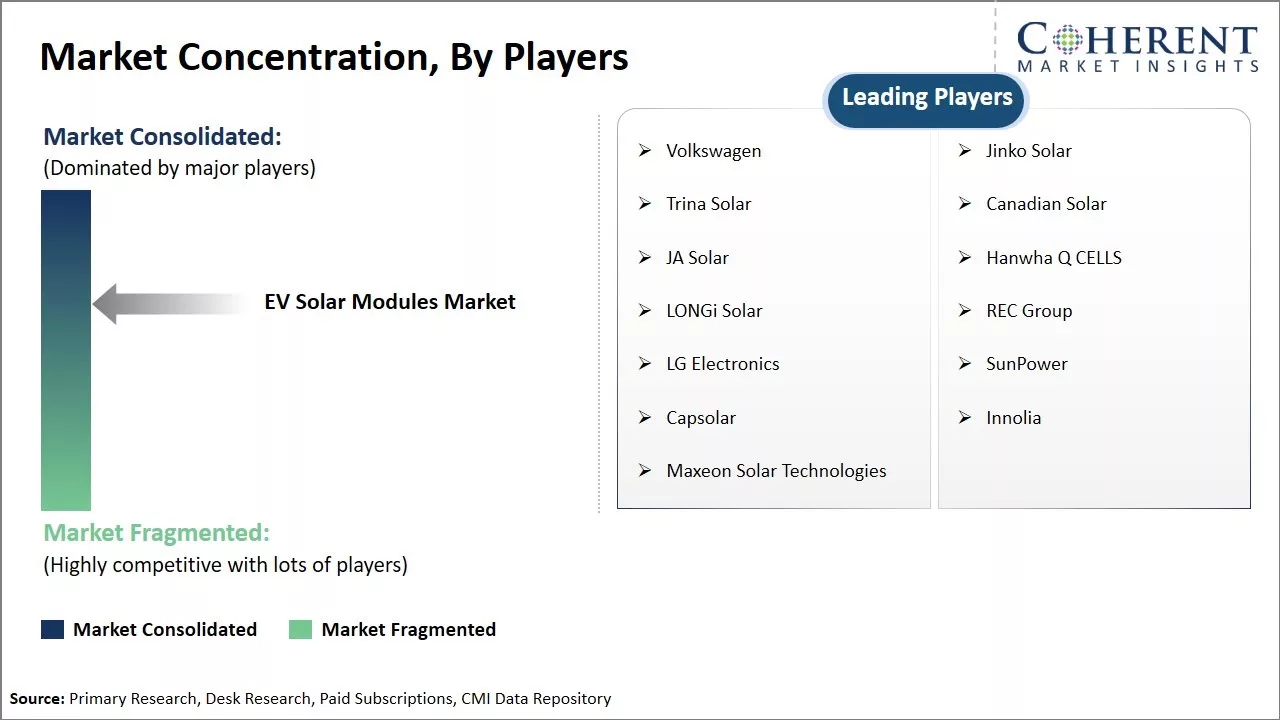
Get actionable strategies to beat competition: Download Free Sample
Rising Deployment of Renewable Energy InfrastructureAnother key factor augmenting the solar modules market for EVs is the growing deployment of renewable energy infrastructure globally. With advancements in solar panel technology, solar power is emerging as one of the most viable and cost-effective clean energy sources. Many countries are investing heavily in utility-scale solar parks and rooftop solar installations to meet their renewable targets. This widespread availability of solar power provides an opportunity to set up more distributed solar EV charging stations. It allows electric vehicles to tap into the renewable energy generated on-site for charging purposes. Moreover, new business models are coming up where third-party solar installation and EV charging companies are setting up combined solar-powered EV fuelling facilities. They offer solar charging services to commercial clients, workplace EV fleets and public places. The growing renewable energy industry thus creates conducive environment for integrated solar-EV solutions. It ensures round-the-clock power availability for EVs through battery energy storage systems. All these factors are raising the popularity of solar EV charging infrastructure and propelling growth in the solar modules market for electric vehicles applications.
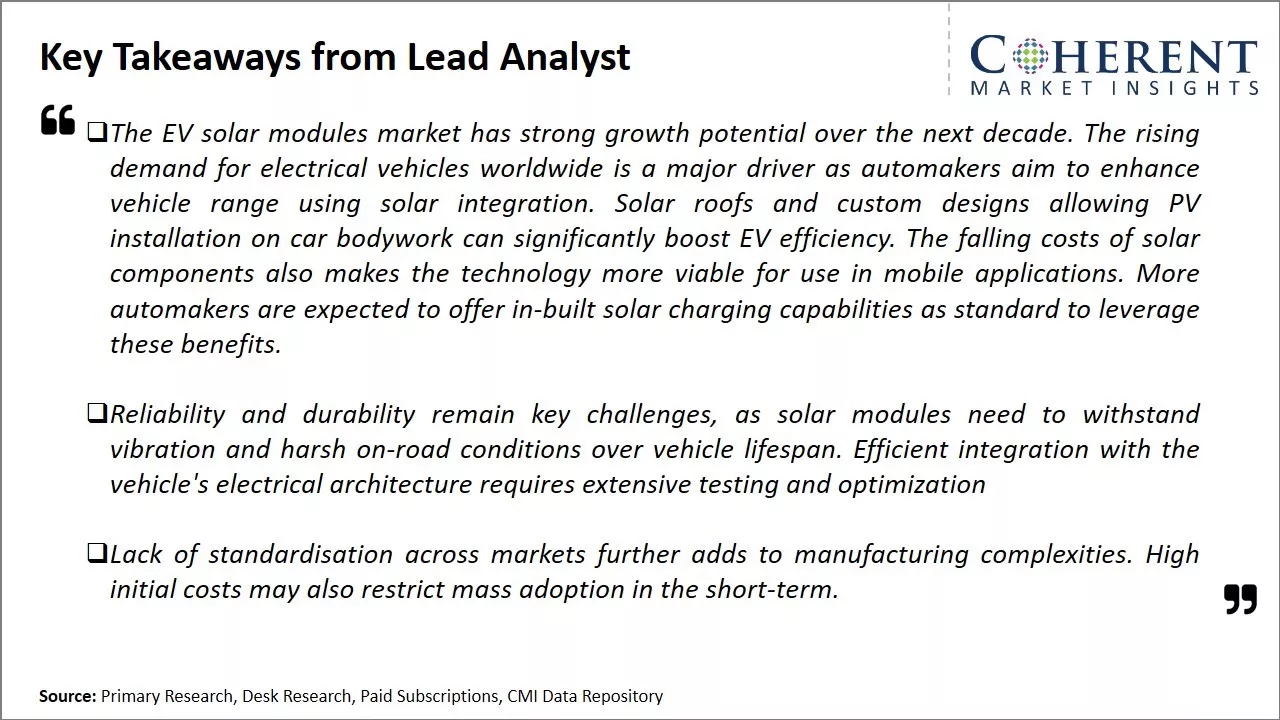
To learn more about this report, Download Free Sample
Market Challenges: High cost of manufacturingOne of the major challenges currently being faced by the EV solar modules market is the high cost of manufacturing involved. Setting up factories and plants to mass produce solar modules for electric vehicles requires huge capital investments. Additionally, the battery and storage technologies needed to store and use the electricity generated from these modules also adds to the overall cost. This high cost poses a significant challenge to widespread adoption in the initial years as consumers may be reluctant to pay higher prices.
Market Opportunities: Increasing focus on renewable energy
With increasing focus on renewable energy and a push for cleaner transportation globally, the demand for electric vehicles is expected to rise substantially. As EV sales increase, the need for ancillary industries and products like solar modules will also witness a parallel rise.
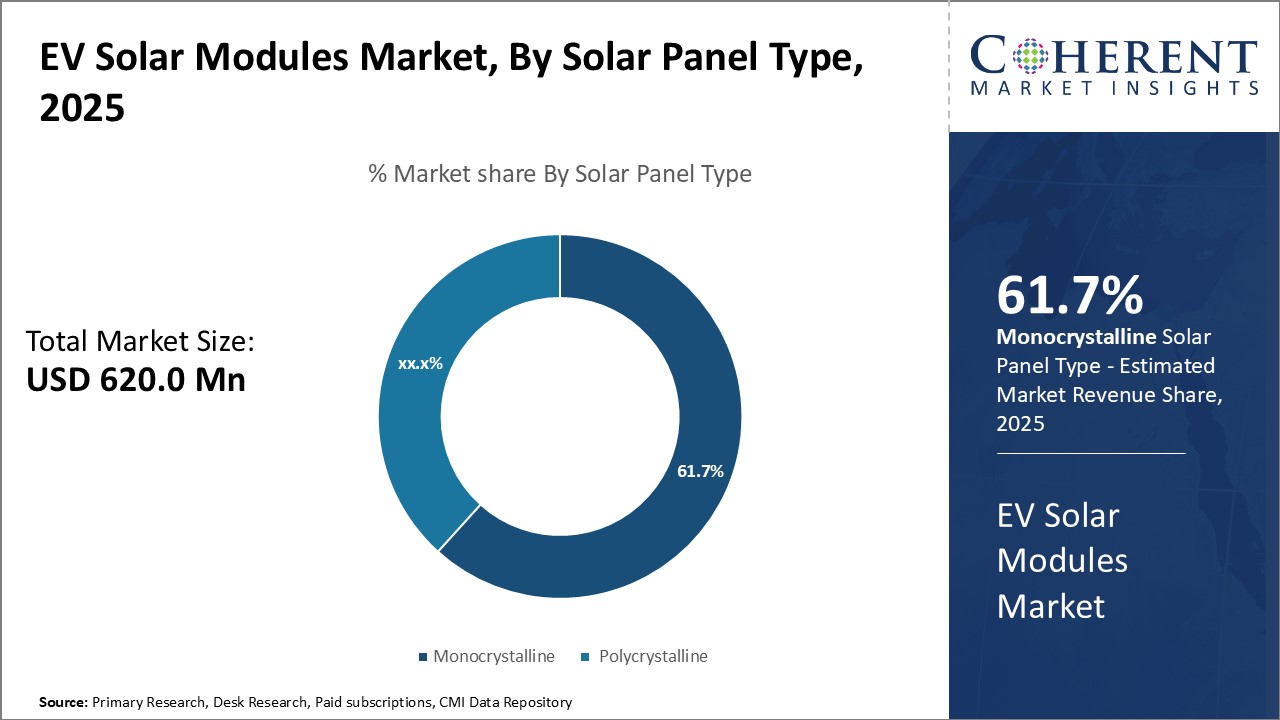
Discover high revenue pocket segments and roadmap to it: Download Free Sample
Insights, By Solar Panel Type: Material SuperiorityIn terms of solar panel type, monocrystalline contributes 61.7% share of the market owing to its material superiority over other panel types. Monocrystalline panels are constructed from a single silicon crystal, giving it a uniform structure that allows it to absorb more sunlight and convert it into electricity more efficiently. The purity and perfection of the crystal lattice allows monocrystalline panels to achieve conversion efficiencies around 20%, which is several percentage points higher than other types. This higher efficiency means monocrystalline panels can generate more power from the same amount of sunlight exposure compared to polycrystalline or thin-film equivalents. The consistent performance over time with virtually no degradation makes monocrystalline the top choice for commercial and utility applications where maximum energy yield is critical. Its higher upfront cost compared to other types is offset by the long-term return on investment delivered through enhanced power generation over the lifespan of the panels.
Insights, By Grid Type: Compatibility with Existing Infrastructure
In terms of grid type, on-grid module contributes 52.1% share of the market as it is fully compatible with existing electricity distribution infrastructure. On-grid systems are directly connected to the public utility grid, allowing any excess power generated from the solar modules to be exported and sold to the grid. This provides a supplemental revenue stream for system owners through feed-in tariffs or net metering policies. The two-way communication capability between the on-grid inverter and local utility makes it simple to switch seamlessly between solar power and grid power depending on generation and consumption levels. Most residential and commercial properties already have grid connections in place, simplifying the installation process for on-grid systems compared to alternatives like off-grid or hybrid setups. The lack of need for battery storage also makes on-grid modules more cost-effective than other options.
Insights, By Application: Cost and Space Effectiveness
In terms of application, passenger vehicles contribute 61.8% share of the market as integrating solar modules is more cost and space effective compared to commercial vehicles. The relatively smaller roof area of passenger cars allows for modules to be installed at a lower total price compared to commercial vehicles like trucks and buses. This makes it an affordable proposition for individual drivers looking to supplement their fuel needs and reduce operating costs over time. In addition, passenger vehicles remain stationary for longer periods each day, parked at homes or in lots, providing optimal conditions for solar energy harvesting. Retrofitting existing passenger vehicle designs with lightweight, aesthetically-pleasing modules has minimal impact on passenger or trunk space compared to commercial vehicles where module addition could impact cargo capacity. This space and size constraint advantage makes passenger vehicles the leading application segment within the growing EV solar modules industry.
Regional Insights
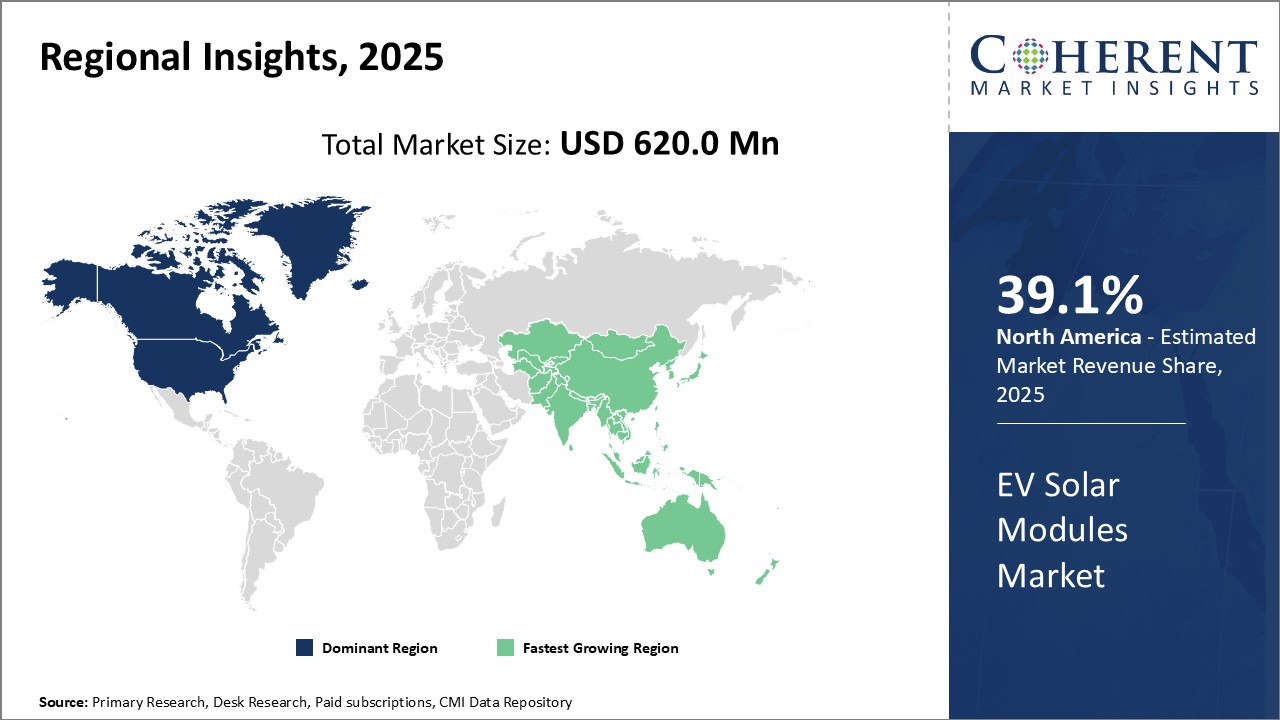
Need a Different Region or Segment? Download Free Sample
The North American region currently dominates the global EV solar modules market. The North America accounts for the largest market share primarily due to strong policy support for EVs and renewable energy at both federal and state levels with 39.1% share. President Biden has outlined ambitious plans to boost electric vehicle adoption and solar energy generation in the country. Several states like California have implemented Zero Emission Vehicle programs that mandate auto manufacturers to sell a certain percentage of emissions-free cars every year. This is creating a consistent demand for EVs and hence solar modules used in them. The U.S. is also home to major EV and solar panel manufacturers such as Tesla, Ford, and SolarCity who are at the forefront of developing advanced solar charging technologies for vehicles. Their continuous innovations are raising awareness and interest among consumers regarding the viability of solar power for EVs.
The Asia Pacific region is poised to be the fastest-growing market for EV solar modules over the coming years. China represents the biggest opportunity, accounting for over 50.5% of global EV production currently. While the country had started late in embracing electric vehicles compared to others, its massive manufacturing capabilities and strong government support through subsidies are helping drive explosive adoption rates now. The 'Made in China 2025' policy specifically focuses on new energy vehicles including solar-powered models. Meanwhile, countries like India and Japan are also witnessing fast EV deployment supported by fiscal incentives and charging infrastructure developments. Coupled with the existing strength of Asia in solar panel manufacturing led by China, the conducive policy environment makes it an attractive investment destination for providers of EV solar integration solutions. As adoption scales up, module prices are expected to decline further, allowing electric vehicles to become more accessible to mainstream customers across the region.
Market Report Scope
EV Solar Modules Market Report Coverage
| Report Coverage | Details | ||
|---|---|---|---|
| Base Year: | 2024 | Market Size in 2025: | USD 620.0 Mn |
| Historical Data for: | 2020 To 2024 | Forecast Period: | 2025 To 2032 |
| Forecast Period 2025 to 2032 CAGR: | 20.0% | 2032 Value Projection: | USD 2,222.8 Mn |
| Geographies covered: |
|
||
| Segments covered: |
|
||
| Companies covered: |
Volkswagen, Jinko Solar, Trina Solar, Canadian Solar, JA Solar, Hanwha Q CELLS, LONGi Solar, REC Group, LG Electronics, SunPower, Capsolar, Innolia, and Maxeon Solar Technologies |
||
| Growth Drivers: |
|
||
| Restraints & Challenges: |
|
||
Uncover macros and micros vetted on 75+ parameters: Get instant access to report
Market Segmentation
- Solar Panel Type Insights (Revenue, USD Mn, 2020 - 2032)
- Monocrystalline
- Polycrystalline
- Grid Type Insights (Revenue, USD Mn, 2020 - 2032)
- Off-grid Module
- On-grid Module
- Hybrid Module
- Application Insights (Revenue, USD Mn, 2020 - 2032)
- Passenger Vehicles
- Commercial Vehicles
- Regional Insights (Revenue, USD Mn, 2020 - 2032)
- North America
- U.S.
- Canada
- Latin America
- Brazil
- Argentina
- Mexico
- Rest of Latin America
- Europe
- Germany
- U.K.
- Spain
- France
- Italy
- Russia
- Rest of Europe
- Asia Pacific
- China
- India
- Japan
- Australia
- South Korea
- ASEAN
- Rest of Asia Pacific
- Middle East & Africa
- GCC Countries
- Israel
- Rest of Middle East & Africa
- North America
- Key Players Insights
- Volkswagen
- Jinko Solar
- Trina Solar
- Canadian Solar
- JA Solar
- Hanwha Q CELLS
- LONGi Solar
- REC Group
- LG Electronics
- SunPower
- Capsolar
- Innolia
- Maxeon Solar Technologies
Share
Share
Missing comfort of reading report in your local language? Find your preferred language :
Transform your Strategy with Exclusive Trending Reports :
Frequently Asked Questions
EXISTING CLIENTELE
Joining thousands of companies around the world committed to making the Excellent Business Solutions.
View All Our Clients
